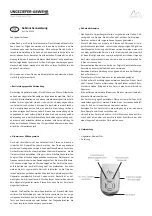
19
One thing to remember is that, when the plane is flying away from you, moving
the aileron stick to the right will make the plane bank to your right.
However, when the model is flying toward you, moving the aileron stick to the right
will make the plane move to your left. Of course, the plane is still responding the
same way, it’s just that your orientation has reversed. This must be kept in mi-
nd while learning to fly (and is also a good reason to take flight lessons from an
experienced pilot!).
To establish a turn, “ up” elevator( pulling back on the stick ) is usually required
along with aileron input to get the model into a bank. To stop the turn, apply a small
amount of opposite aileron.
Once you get the plane into the air and have climbed to a comfortable altitude,
the first “order of business” will be to “trim” the model for straight - and - level
flight. The model flies best at approximately 3/4-throttle. Adjust the trims on the tran-
smitter to make minor control surface adjustments as necessary until the plane will fly
straight without any control inputs. Often, your assistant can reach over and adjust
the trims for you.
Remember to keep the model high enough to give yourself time to make correcti-
ons, but don’ t let it get too far away. Otherwise, it will be difficult to detect its attitude
and which way it is going.
One
final check before landing: see how the model will react when it’s time to land
and you cut the power. To do this, while still at altitude, cut the motor power.The
model should establish a gentle, downward glide path.
This is how the model will react when it’s actually time to land. Add power and
climb
back
up to your original
altitude
.
Try again
, this time adding flaps.
To climb, add throttle and immediately take the flaps back out. Practice a few of these
“ climb and glides ” to judge how far out you will need to be when its time to land.
Flying



































